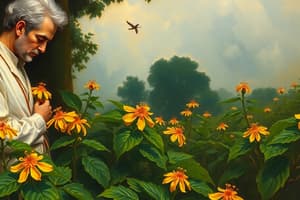Podcast
Questions and Answers
Tu Youyou developed a method for extracting active ingredients from ______, a medicinal plant.
Tu Youyou developed a method for extracting active ingredients from ______, a medicinal plant.
qinghao
Artemisinin was successfully licensed for use in ______.
Artemisinin was successfully licensed for use in ______.
1986
In 2015, Tu Youyou shared the Nobel Prize in Physiology or Medicine with ______ and William C. Campbell.
In 2015, Tu Youyou shared the Nobel Prize in Physiology or Medicine with ______ and William C. Campbell.
Satoshi Omura
Artemisinin combination therapy (ACT) has successfully treated over ______ million people worldwide annually.
Artemisinin combination therapy (ACT) has successfully treated over ______ million people worldwide annually.
Tu Youyou is currently working as a chief scientist at the ______ Academy of Traditional Chinese Medicine.
Tu Youyou is currently working as a chief scientist at the ______ Academy of Traditional Chinese Medicine.
Tu Youyou tested 380 extracts from 200 plants for their ability to kill malaria-causing ______ parasites in mice.
Tu Youyou tested 380 extracts from 200 plants for their ability to kill malaria-causing ______ parasites in mice.
The extract of ______ annua, also known as qinghao or sweet wormwood, initially seemed favorable for treating malaria.
The extract of ______ annua, also known as qinghao or sweet wormwood, initially seemed favorable for treating malaria.
In Chinese medicine, a standard preparation technique involves ______ the root of the plant to make a decoction.
In Chinese medicine, a standard preparation technique involves ______ the root of the plant to make a decoction.
A mortar and pestle is used for ______ plant material when preparing herbal medicine.
A mortar and pestle is used for ______ plant material when preparing herbal medicine.
The label on the herbal medicine preparation shows the name ______ in large lettering.
The label on the herbal medicine preparation shows the name ______ in large lettering.
Tu Youyou was awarded the Nobel Prize in Physiology or Medicine in ______ for her discovery of artemisinin.
Tu Youyou was awarded the Nobel Prize in Physiology or Medicine in ______ for her discovery of artemisinin.
Tu contracted ______ as a teenager, which spurred her interest in medical research.
Tu contracted ______ as a teenager, which spurred her interest in medical research.
In 1969, Tu Youyou headed a team to find a new ______ after several failed compound trials.
In 1969, Tu Youyou headed a team to find a new ______ after several failed compound trials.
The parasite that causes malaria is transmitted by ______.
The parasite that causes malaria is transmitted by ______.
Within three months, Tu Youyou's team gathered more than ______ compounds obtained from Chinese medicine.
Within three months, Tu Youyou's team gathered more than ______ compounds obtained from Chinese medicine.
The Chinese government appointed Tu to lead ______ to discover new antimalarials.
The Chinese government appointed Tu to lead ______ to discover new antimalarials.
Tu Youyou's research integrated traditional Chinese medicine and modern ______ approaches.
Tu Youyou's research integrated traditional Chinese medicine and modern ______ approaches.
Tu Youyou is the chief scientist at the China Academy of Traditional Chinese Medicine in ______.
Tu Youyou is the chief scientist at the China Academy of Traditional Chinese Medicine in ______.
Flashcards are hidden until you start studying
Study Notes
Artemisinin: A Revolutionary Drug
-
Malaria Threat: Malaria, caused by the Plasmodium parasite spread by mosquitoes, was a major health issue in the late 1960s and early 1970s. Resistance to existing medications like chloroquine emerged, prompting the need for a new treatment.
-
Tu Youyou's Discovery: In 1971, Chinese scientist Tu Youyou identified artemisinin, a powerful antimalarial drug, extracted from the Artemisia annua plant (qinghao or sweet wormwood).
-
Ancient Herbal Medicine: Tu Youyou's research included studying traditional herbal medicine, including Handbook for Emergencies by Ge Hong, which guided her extraction process. The ancient recipe used low-temperature methods with ethanol, water, and ethyl ether.
-
Project 523: Tu Youyou led a team in Project 523, assigned by the Chinese government to find a new antimalarial from traditional resources. They tested over 2,000 compounds within three months.
-
Artemisinin Extraction: Tu Youyou's team effectively extracted artemisinin from the Artemisia annua plant using a novel low-temperature process.
-
Clinical Trials and Advancements: Clinical trials on humans began in 1972. Artemisinin was licensed for use in 1986. Tu Youyou further developed dihydroartemisinin, a more potent form, in 1992.
-
Artemisinin Combination Therapy (ACT): Today, ACT is widely used globally to treat malaria, benefitting over 198 million people annually.
-
Awards and Recognition: Tu Youyou received the Lasker Award in 2011 and the Nobel Prize in Physiology or Medicine in 2015, along with Satoshi Omura and William C.Campbell, for her contributions to malaria treatment.
Omura's Contribution
- Ivermectin: Japanese microbiologist Satoshi Omura discovered ivermectin, a key anti-parasite medication for various diseases. He also received the Nobel Prize in Physiology or Medicine in 2015.
Tu Youyou: A Pioneer in Pharmacology
-
Early Life and Inspiration: Tu Youyou developed an interest in medical research after contracting tuberculosis as a teenager. Her research into parasitic diseases like schistosomiasis was foundational for her work on malaria.
-
Career Highlights:
- Joined the newly formed Academy of Traditional Chinese Medicine.
- Led a team to find a new antimalarial in 1969.
- Used ancient Chinese medicine knowledge to discover the artemisinin extraction technique.
-
Continued Impact: She remains the chief scientist at the China Academy of Traditional Chinese Medicine, serving as a World Health Organization Collaborating Centre for Traditional Medicine.
Key Points
- Tu Youyou's research combined traditional knowledge with innovative extraction methods, resulting in a major breakthrough in malaria treatment.
- Her work is a testament to the power of interdisciplinary research, integrating traditional medicine with modern scientific approaches.
- Artemisinin and ACT have significantly reduced malaria incidence worldwide
Studying That Suits You
Use AI to generate personalized quizzes and flashcards to suit your learning preferences.





